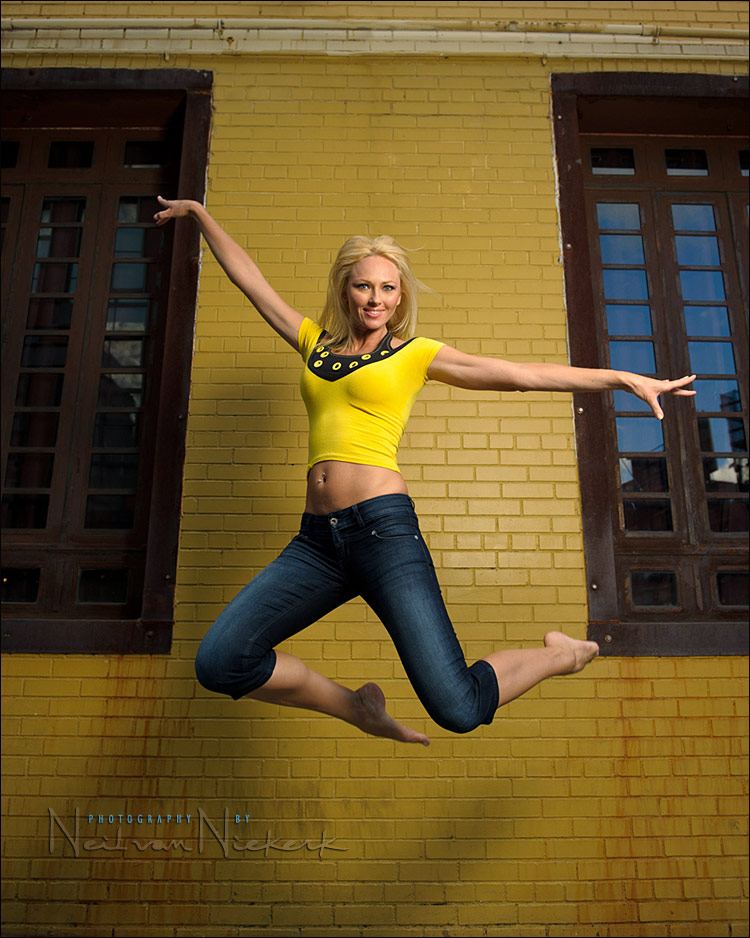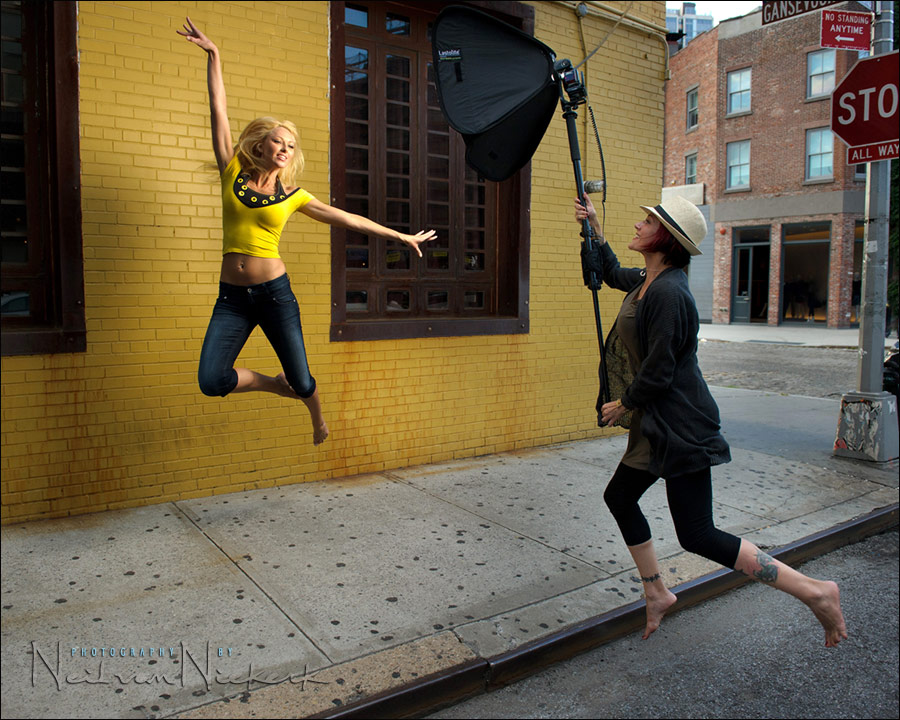
Using high-speed flash sync / Auto FP
Going to High-Speed Flash sync, ie, over maximum flash sync speed, comes with a penalty – loss of flash power. This might be a crucial thing when we are shooting in really bright light, and need to match that with flash. So here’s a solid recipe for when it makes most sense to go to high-speed flash sync / Auto FP.
High Speed Flash Sync makes most sense when you need either
– shallow depth-of-field, or
– fast shutter speeds,
and
– you have the flash power to spare.
As mentioned in the tutorial on high-speed flash sync (HSS), there is definite loss of power in going into high-speed flash sync territory. So you wouldn’t immediately use HSS in very bright light if you are trying to match the sun with flash. While the higher shutter speeds brings the ambient exposure down, it brings the effective flash power down faster than it affects the ambient light. So the sweet spot will always be at maximum flash sync speed. Therefore, using HSS shouldn’t just be a default way of working flash. This is also discussed at length here: When to use high speed flash sync (HSS).
With this image above, the softbox was close enough to Aleona that we were able to get good flash exposure on her, even at a high shutter speed. However, we did remove the one baffle of the softbox.

A fun image taken during a personal workshop – our model, Aleona caught-mid-air … with a fast shutter speed and flash, to freeze the movement. Even Jessica, my assistant with the ‘tood, was positively elevated with the experience of photographing Aleona.
camera settings: 1/1000 @ f4 @ 800 ISO
The faster shutter speed was there to help freeze her movement. I had to bump the ISO up to get to that speed. I could have stayed at 1/250 @ 100 ISO, but that shutter speed might be a touch too slow to freeze movement. We can’t rely on the flash to freeze action, because the available light is relatively bright in comparison. You can’t necessarily rely on flash to freeze the movement, so the higher shutter speed is necessary.
Summary
Use high-speed flash sync when you need the higher shutter speed OR shallower depth field, AND can afford the subsequent loss in power.
Related articles
- Tutorial on high-speed flash sync
- When to use high speed flash sync (HSS)
- Controlling bright daylight with direct off-camera flash
Photo gear (or equivalents) used during this photo session
- Nikon D3s
- Nikon 24-70mm f2.8G AF-S / Canon 24-70mm f/2.8L II
- Lastolite EZYBOX 24×24″ softbox
- Nikon SB-910 Speedlight controlled by PocketWizard FlexTT5 & AC3 Controller
or alternately, the Canon 600EX-RT Speedlite controlled by Canon ST-E3 Transmitter
Best photo I’ve seen for you Neil, that was a refreshing post. :-)
Eat your heart out, Isaac Newton!
My favorite outdoor setup these days, Neil. Love the shallow DOF.
Great shots and inspiration as usual :)
With these fun shots, it’s hard to focus on the text. :-)
The more people there are “levitating” in the shots, the more surreal they look. I love it!
I couldn’t levitate to the extent the two girls did. It has something to do with my power-to-mass ratio.
Also, it’s tough to jump with a Nikon D3 and Nikon 70-200mm f/2.8 …. that’s a heavy combo that I had to swing upwards before jumping, just to get some momentum to the camera and lens!
What was the flash used in the box?
Tid, it was a speedlight. In this case, the Nikon SB-900
No one ever seems to mention the use of neutral density filters. It seems to me that this is good way to cut down the ambient light into a range where the flash and camera would not be operating in high speed sync mode. Aside from not having enough hands to juggle a filter along with everything else, am I missing something here?
Jeff, a neutral density filter works wonders when you want that shallow depth-of-field without sacrificing the flash power.
But a ND filter wouldn’t help you in a case like the two photos at the top, where there is action and you want to freeze the movement. Then you need the faster shutter speed.
With the image of Aleona jumping, I was chasing the faster shutter speed, not the shallow DoF.
Thanks for making me smile this morning! Especially loved the last shot.
Hi Neil,
Funny and refreshing!
I was under the impression that high speed sync can only go to 1/400 (in the Nikon anyway). I guess it’s the PW that gives you the higher speed sync? Just out of curiosity, would it fair to say that you are using about ten times more flash power this way?
Cheers,
Motti
Nope … it’s not due to the PocketWizards.
Put a speedlight on your camera, and …
if you have a Canon, hit the lightning symbol on the back of your speedlight, or …
if you have a Nikon, it is most likely custom function E1 to enable Auto FP mode, …
and then crank up the shutter speed. See where you end up.
Cool, great work!
You can depend on Neil and Jessica for some very good outtakes. :-)
The reference shot of Jessica near Aleona really is sobering. You aren’t kidding when you state that HSS cuts the effective flash range by half or more. Jessica is really close to the model: 2-3 feet.
Keep in mind that this was shot at 24mm … so there is some spatial distortion.
For starters, Aleona is a 6’1″ (or 6’2″) Russian goddess / model / dancer. Jessica is … less majestically tall. But in this image, Aleona looks much smaller than Jessica.
So the softbox wasn’t quite as close as 2 ft, but yes, HSS kills substantial amounts of flash power the higher you go up in shutter speed.
Neil,
Two more questions:
1) Dynamic AF on the Aleona’s eyes? Even though this is not sports photography, Aleona’s eyes are fairly sharp.
2) Machine gunning the shutter or taking the shot at the height of the jump (anticipation)? I figure machine gunning would be bad since the flash would not have time to recharge.
Pre-focus using Single AF mode. Remember, she is jumping vertically in relation to the camera.
Nope, you can’t machine gun with the softbox, since the flash is firing close to full power.
With the shot of the three of us jumping, Jeff did fire it at 9 frames per second, with the speedlight firing with every shot. But these were just short blips of light.
Awesome shot! Nice explanation too, clear and easy to comprehend.
Neil,
Thanks for the reply! I was too busy being entranced by the freeze-frame photo to realize that Aleona was jumping straight up, so she would still be in the same plane of focus as your pre-focus point. :-)
1. Do you have to use su-800/speedlight as trigger for HSS to work?
2. Do you need it for rear sync also?
3. Or will the new PWs work with both?
1. No, you don’t need an SU-800 or ST-E2 for high-speed flash sync.
You just need a speedlight and camera that allows it.
High-speed flash sync need not to off-camera flash. You can use your on-camera speedlight in HSS mode.
2. Rear curtain sync and high-speed flash sync are completely unrelated.
You can even say that HSS is the opposite of dragging the shutter. i.e. … a slower shutter speed when using flash. Only THEN can you consider first or rear curtain sync as options.
In fact, this is made quite obvious on the Canon speedlights, where you have 3 options on your speedlight:
a. “nothing going on except the flash going off”
b. high-speed flash sync (the lightning bolt)
c. rear curtain sync.
This makes it impossible to consider the notion of having HSS and rear-curtain sync.
3. The new PWs and the Radio Poppers will work with both modes.
To correct, Aleona is 5’11” and I’m 5’7″ – still “less majestic” than Aleona, but not by much!!!
Yes, when the speed light is on the camera body I can go as high as 1/8000, but I did not know that it was possible with a radio trigger (of-camera like you did). Not mine anyway.
My radio trigger (the cheap version) is capable of shutter speed of maybe 1/160. I was told long ago that the PW can go up to 1/400. I see at B&H site that the new PW you have can go to 1/8000.
I don’t think that any other radio triggers can do that, I maybe wrong.
Philippe Halsman would be flattered! Very nicely lit, and a fun presentation too. Good stuff.
Oh, we were just trying to comply with the warning sign there, “No Standing Anytime”.
Would i be right in saying if you’re using the PW TT system you don’t need to switch HSS on via the flash right? I believe these units intelligently know and take care of business as you select high shutter speeds. If you plug the PW into the computer you can set where the intelligence kicks in.. i think 1/350 is the default setting.
Also a lot more efficient: “Because the new MiniTT1 Transmitter and FlexTT5 Transceiver communicate through-the-shoe with the camera system, they can control the HSS burst duration. By precisely matching flash duration to the shutter speed, large gains in efficiency are found, as much as 70% in many cases, for both remote and on-camera flashes.”
Anyway nice to see this is action Neil, it’s certainly a post i’ve been looking forward to seeing.
Since you mention enabling the HSS via the flash, it sounds like you’re talking about the Canon system.
I’m not sure that HSS would kick in at 1/350 … since with the Canon 5D, the max sync speed is 1/200 and then a 1/350 setting would leave 1/250 as a grey area in terms of the electronics. But then, I haven’t messed around with these default settings at all in the firmware.
Anyway, the TT5 units take care of enabling the flash to go in to HSS territory.
There is one caveat though … your first shot, which establishes communication between Master and Slave, needs to be at or below max sync speed. Unlike the Radio Poppers, you can’t already start off in HSS territory.
If you play with the HyperSync slider in the firmware you can squeeze 1/250 out of the 5Dmk2’s flash sync speed.. I think -300 is the setting and you need only change it on the TT unit which sits on the camera or all it doesn’t hurt.
I tried it but sometimes you get a very faint dark line from the aperture blades on one side, but only once in a while and it’s very small and easily cropped out.
The online chart for HyperSync (not to be confused with high speed sync can be found here:
Thanks for the heads up regarding communication shot, i didn’t know about that.
As always Neil, great shot, excellent explanation and outstanding sense of humour.